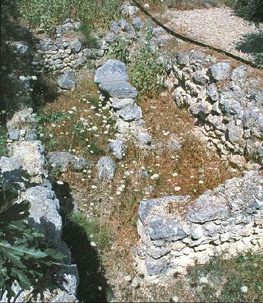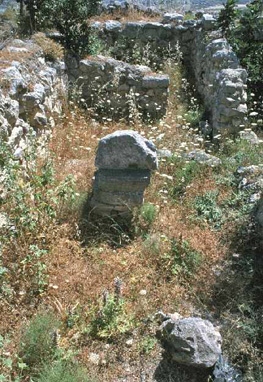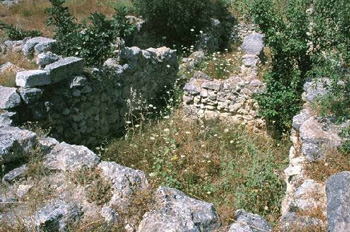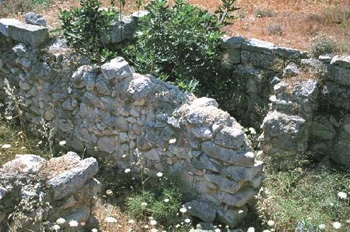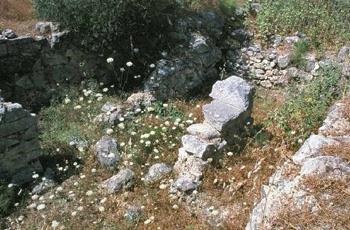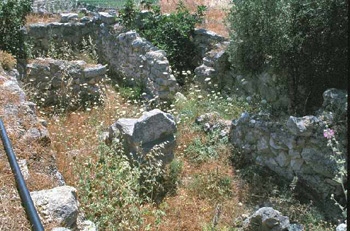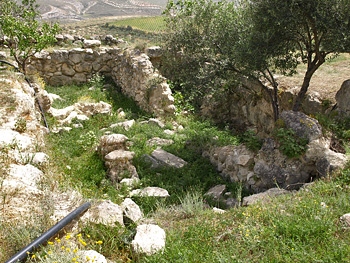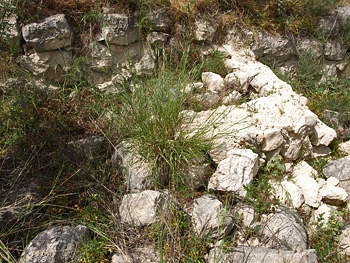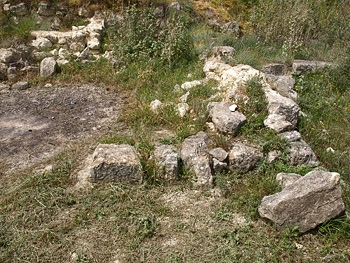A story of neglect
The archaeological site at Prassa was discovered accidentally in 1939 and although excavations began that same year and continued in 1940 they were interrupted (presumably by the German invasion) and not resumed again until 1951. The first finds to emerge were polychrome cups dating from MM I. Part of an extensive building was uncovered and it became clear that there were remains of other buildings nearby.
The uncovered area had basement rooms preserved to a height of three metres which had been occupied in two separate phases in the Bronze Age -- Middle Minoan I to Middle Minoan II (protopalatial period) and Middle Minoan III to Late Minoan IA (neopalatial period). As well as a large number of various stone and clay vessels, pieces of wall fresco were also found, although these fragments were small and few in number. The renewed excavation of the site was all the more urgent as the uncovered (and unpublished) remains had begun to deteriorate as a result of their exposure to the elements.
Unfortunately over the last ten to twelve years the site has been allowed to deteriorate badly. It is located in an olive grove and it is quite likely that the local farmers, who use the site for routing and storing water pipes may have been responsible for some of the damage. Several small trees are growing in the basement rooms and these will only cause more damage over time. The site really needs to be cleared and cleaned and then fenced off to prevent any further damage. This may not happen if the hard pressed archaeological service is not given the resources to carry out such a task.
Two houses of what is assumed to be a small settlement were excavated, House A and House B. In House A, the four basement rooms at the north end of the building, A, B, Γ and Δ, which had been uncovered in 1939-40 were cleared. To the south some ground floor rooms were also uncovered but at first it proved difficult to understand them due to extensive damage in the past.
Building A
In room A of House A, 16 circular depressions of various diameters were found along the length of the four walls apart from one depression which was located in the middle of the room. The earth which they contained was darkened and clearly contained carbon. This was possibly the result of the charring of animal or plant matter. Sherds removed from this level established that it was only in use during the protopalatial period.
It seems that during the second period, corresponding to the Neopalatial period, the superimposed planking, of which many charred remains were found throughout the room, covered these depressions which perhaps had originally been used to secure pithoi of various sizes. A wall separated room A from room B and until twelve years ago most of this wall was still standing. Since then it has almost completely disappeared.
In basement room B the soft rock which supported the wooden floor had been cut at two levels. The level inside the room was 15 cms higher than the lower level, which constituted a sort of passage. On the upper level there was an unusual construction which the excavator likens to a shrine, with an internal partition and a very narrow entrance from the west. In the north west corner of the room there was a narrow niche formed by the meeting of the two walls. Much of this shrine has fallen in the last ten years so that little of it now remains.
To the west of Room B, a very small, square room was found, with two large, heavy and irregular stones blocking the opening. It seems that this was a depository into which pottery, perhaps broken or no longer used pottery from the shrine, had been placed. Inside, undecorated conical cups, were found, similar to a large number of cups that were found in a thick layer all along the west wall of Room B.
Room B also produced decorated pottery dating to MM IIIB-LM IA. Among the finds were one-handled, black-glazed cups, some of which were decorated in white, (one piece with double axes); fragments from two large bridge-spouted jugs decorated in white with double axes combined with the sacral knot on a dark brown background; small, delicate decorated jars; and two cups of the transitional period, one with a thick lattice decoration and another with a simple spiral decoration. Also found was an amphora decorated with white spirals on a grey background and two other large vessels for domestic use. In the view of the excavator, these finds from the west part of room B together with the abdundance of conical cups, identical to those found in the depository strengthened the view that the room was used for religious purposes.
When the other two basement rooms which had previously been excavated were cleaned in 1951, the thresholds of the rooms were uncovered and Room Γ (Gamma) was found to contain a staircase leading to an upper floor, of which three gypsum steps remain in situ. Room Δ (Delta) contained a deposit of protopalatial vessels. Two gypsum jambs had been placed between rooms B and Γ. Two other gypsum jambs had been found in the earlier excavation near the partition wall between rooms A and B but in a higher layer which it seems had come from the polythyron hall above these rooms on the ground floor.
All the remaining rooms of House A belong to the ground (first) floor. On the east side there appears to have been a veranda which may have run the whole length to the east of rooms Eα and Eβ. Its pillars would have been based on the wide external east wall. Room Eα opens through two doors into rooms Z (Zeta) and H (Eta) but the west wall of room H was not found. Room Z was somewhat better preserved. Just inside the entrance from room Eα in the north east corner of the room there was a small square stone base, part of a support for whatever was above. The excavators believe there would have been a second support a little further to the south in Room Z. There was also an entrance from the corridor in the south east corner of Room Z. This corridor may have been the main entrance to the building from the east. There had also been a wide opening in the west wall of room Z which had later been filled in.
Excavations to the south of room Z uncovered a staircase which may have been constructed of wood apart from the stone base found in situ. There would have been a small area beneath the staircase, labelled a sotto scala by the excavator. To the south of the staircase, another entrance was discovered, complete with a door jamb and threshold, which led to the staircase and to the area to its east which has largely been destroyed. The most southerly part of the building consists of poorly built and poorly preserved walls, built onto the soft rock, which were a later addition contemporary with other remains of walls seen all over the site and especially the filled in wall of Room Z.
Finds from these rooms included pestles, pieces of stone lamps, several cups, small gournes made of soft stone, a beautiful stone handle, perhaps from a rhyton, with two small holes for securing it, and a steatite amygdaloid seal decorated with a linear design.
Building B

A short distance to the northwest of Building A, excavators uncovered Building B, a more or less square building with four rooms, A, B, Γ and Δ. The facade had been constructed with ashlar masonry. According to the excavator Room A communicated with rooms B and Γ (although room Γ is shown as having no entrance through its walls in the published plan). However, there was no way to communicate at all between rooms Γ and Δ. So room Δ, and possibly room Γ as well if the plan is correct, would have been accessed from above, probably using a wooden ladder. Such rooms were often used as storerooms.
To the east of Room A and at a slightly different angle to Building B, a small room (E) had been added at a later date and it is not known what its purpose was. The south wall of room E overlapped the southeast corner of room A.
Room A was a kitchen. In the northeast corner cooking utensils were found wedged between stones deliberately placed to form a square. Among the utensils found were two tripod cauldrons and the bottom part of another vessel. Also found was a stone gourna with a deep cavity in the form of a mortar, but which had a pierced bottom, and was perhaps some kind of sink. On the south wall a piece of slate had been placed vertically. Behind it there was a pitcher. Next to the pitcher there was something resembling a bench or an oblong block. Finally in the southwest corner of the room there was a very narrow opening where the lower part of three vessels were found. It seems that the hearth was located here and the opening existed to help draw the fire and also let out the smoke.
Room B was both much smaller and much narrower. The fill which had been used to level the irregularities of the rock floor contained a lot of clay sherds from the protopalatial period. It seems, therefore, that House B was built during the neopalatial period unlike House A, which had been built in MM IB and was reused in the neopalatial period.
By the threshold of rooms A and B a small rectangular limmestone receptacle was found, possibly for receiving libations. On all sides of the receptacle, there were inscriptions in Linear A characters carved into the stone. These were recognised as relating to ritual vessels.
In room Γ a tall cylindrical vessel with a curved handle was found. The upper part was quite deep and almost cylindrical and was possibly used to contain burning charcoal. There were two holes opposite each other through which it is thought a stick could be passed and used to move the vessel when it was hot from the burning charcoal. Many incomplete vessels and the lips of pithoi were found in all the rooms of House B, while two incomplete lamps were found in room A.
The excavator, N. Platon, believed that these two buildings were not the only ones in the area. The remains of other walls had been noted in the past, not on the same orientation as Buildings A and B but from the same period. To the northwest of Building B walls were identified and were named as Building Γ. Two jugs which were unearthed there suggested a LM IA date, but unfortunately the building has suffered great damage from agricultural activity. It is not clear whether the buildings at Prassa were destroyed by fire and earthquake in LM IA or whether they were rebuilt, only to be destroyed again by earthquake later in the same period. But while the settlement existed it overlooked the small plain of Amnnisos and possibly controlled the road in that area which led towards Knossos on which it was no doubt dependent.
PHOTOGRAPHS: The area was completely overgrown when I visited it over ten years ago. The photographs here show the basement rooms from House A which was all that was visible at the time. When I returned in April 2013 the wall dividing rooms A and B and the structure in room B had both been badly damaged. Almost none of the wall remained and the upper levels of the structure had gone. Consequently I am leaving the old photos on this page, even though they are very low resolution photos, as they give a better idea of what the site used to look like. I have added a photo to show the damage and a couple of photos of other rooms from Building A, which sadly are also in a very poor state.

